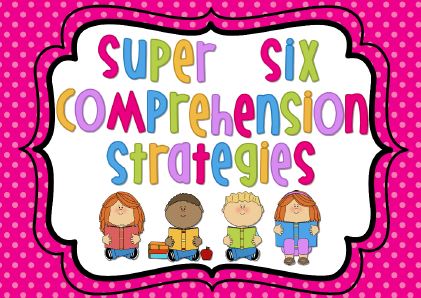Here's a summary of how it was used in my year 1 classroom. This was not done in one lesson, but multiple lessons over a few weeks.
First of all we had a discussion about the meaning of the word text (check out my freebie poster in the previous post). We talked about how reading was not just about books and how we can read posters, music, diagrams e.t.c. This was an important concept as the students would be using the comprehension strategies with a range of texts.
Once the students had grasped that idea, it was time to introduce The Super Six! The first strategy was Visualising. We did a lot of activities that involved listening to passages and music. Students were asked to draw what they thought characters, objects and scenes looked like. It was important to emphasise that it's okay if their visualisation looked different to their friends'. Once they drew their pictures they were able to share their pictures and explain how they came to their visualisation. Ideas for texts; The Gruffalo, The Twits and any rainforest music.
The next strategy was Predicting. Students were already familiar with this, but I wanted to take it a bit further by getting them to explain how they reached their prediction. I also introduced them to the thinking stem "I predict...". We also started using this strategy for informational texts. They started to use features of the text like subheadings, text boxes and diagrams to assist in their predictions.
After that we covered Making Connections. We started off with Text to Self Connections with the thinking stem "This reminds me of...". Students wrote sentences in their journals using this stem and drew pictures. We then moved on to Text to Text Connections with the thinking stem "This remind me of......because....". This was a great opportunity to use traditional fairytales and the remakes of them (I.e The Three Little Pigs and The True Story of the Three Little Pigs). Then we focused on Text to World Connections. I picked out texts that I knew had something related to what we had done in school. A good text for this was George Saves the World by Lunchtime as we had previously been learning about recycling and had implemented a few green practices in our classroom.
Next up was Questioning. For this strategy we focused on the thinking stem "I wonder...". This helped the students come up with questions that required deeper thinking. We asked questions before, during and after reading.
Summarising was introduced by linking it to when we give news. We talked about how we only give the main points and don't talk about the little, unimportant things. To get students started we used the "Somebody wanted, but, so" strategy. We started off verbally, then drawing and then writing. Once students were confident with this we then moved on to a more detailed version using time connectives. We also had alpha boxes which we used to list the key words from the topic we were focusing on. This also doubled as a word wall.
The last strategy was Monitoring. We talked about what we could do if we didn't understand what we were reading. The students came up with answers like "ask the teacher" or "look at the pictures". We talked about how sometimes the teacher won't always be available to help and that there were things the students could do themselves to help. These were introduced as "Fix Up" strategies complete with a Bob the Builder picture and his catch phrase "Can we fix it? Yes we can!". Strategies we talked about; using pictures, rereading, asking questions, predicting based on what has happened so far, summarising and asking a friend.
Once these introduction lessons were done, we incorporated the strategies in our everyday routines and students started using them on their own without prompting. The use of thinking stems also encouraged deeper conversations and more sophisticated language.
The Super Six definitely made a positive impact on my classroom and the way students were learning. I would encourage anyone to give it a go.


There is only one thing in life worse than being talked about, and that is not being talked about. See the link below for more info.
ReplyDelete#talked
www.ufgop.org
SMM PANEL
ReplyDeletesmm panel
iş ilanları
İNSTAGRAM TAKİPÇİ SATIN AL
Https://www.hirdavatciburada.com/
WWW.BEYAZESYATEKNİKSERVİSİ.COM.TR
Servis
Tiktok Hile